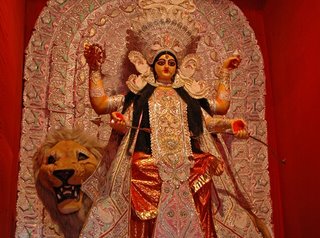Jagaddhatri

The traditional Durga Puja is 'akalbodhan' -- an untimely invocation -- of the ten-armed demon-slaying Goddess to fight the forces of darkness. Before Durga Puja and Kali Puja became institutionalized in September-October, the Goddess was worshipped at different points in the harvesting cycle as a more benevolent fertility mother -- Basanti or Spring in March, and Jagaddhatri or Universal Mother in November. Jagaddhatri is, then, a more benign Shakti -- traditionally modeled with four arms instead of ten.
In spite of the akalbodhan Durga Puja being more recent in practice, the shastras still put it in greater signficance temporally. According to the Puranas, the gods became very proud at the end of the defeat of Mahisasura. They considered the victory to be due to the weapons they had lent Durga. One day Brahma appeared in front of them as a yaksha. The gods started boasting of their powers -- Vayu, for example, carried on about how his gusts could uproot trees. The yaksha put a little cup of water on the grass and challenged Vayu to blow it away. No amount of puffing by the wind god could ripple the cup. The gods were chastened to be reminded of the Supreme Force that rules over all -- and worshipped this Force as Jagaddhatri.
It would seem that various forms of the Goddess were in traditional worship right on down from prehistory; but as that traditional society in Bengal was ground down into impotence by arbitrary, cruel and violently patriarchical Turko-Afghan rule, the Durga form as a destroyer of usurping demons, and the Kali form as a vengeful protecting mother, gained appeal, though the other forms did retain some local followings. Jagaddhatri is mentioned in Krishnananda Agamvagisha's Tantrasara as an established deity. The zamindars of Chandannagar patronized Jagaddhatri in the 17th and 18th centuries, and the worship of a towering Jagaddhatri still anchors tourism in Chandannagar.
(Jagaddhatri picture at College St. courtesy of www.shunya.net.)


0 Comments:
Post a Comment
<< Home